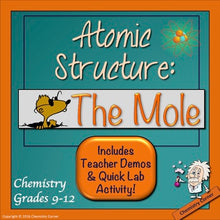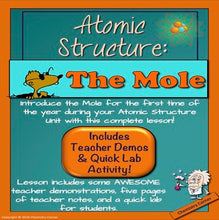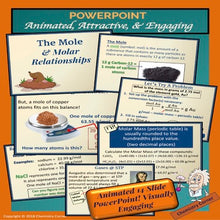First lesson of the year on moles! I like to introduce the mole during my atomic structure unit. (counting atoms) This time of year usually falls not long after the unit on dimensional analysis making it fresh on student’s minds. By putting this first mole lesson here, it reinforces dimensional analysis, and brings the mole in to play early in the year. I usually stick in another mole lesson after nomenclature and before reactions for more reinforcement before stoichiometry.
This lesson begins with teacher demonstrations that will allow students to visualize the relationship between amu and grams on the periodic table. Not such an easy leap to make for students. But, with these demonstrations, students will gain a deep understanding of how it all ties together. Then, your students will follow the PowerPoint lesson with their Cornell style notes. At the end of this lesson your students will have mastered molar relationships and mole conversions!
You will love this instructional strategy that is based on 23 years of experience that will have your students mastering this difficult concept in just one lesson!
A student quick lab is included with detailed teacher instructions.
Objectives:
* The student will define the mole in terms of Avogadro’s number.
* The student will use the periodic table to determine molar masses of pure substances.
* The student will perform calculations involving mass in grams, amount in moles, number of atoms in a pure substance, and molar volume.
* The student will apply lesson concepts in the lab.
If you don't teach molar volume at this time, the lesson includes instructions for differentiating this lesson.
Prior Knowledge for Students: Students need to have experience with dimensional analysis.
Teacher Prep Time: Medium. Some prep required for the demonstrations, and the lab. Everything else is print and go!
Lesson Duration: Direct Instruction- One Class period. 2-3 class periods depending on class length, and amount of practice.
This lesson goes well with my Chemistry Board Game: Conversion—Dimensional Analysis Edition which includes mole conversions.
Included in This Product:
* Editable, Animated PowerPoint (24 slides)
* Cornell Style Student Notes that follow the PowerPoint (Cloze Notes & Blank Notes)
* Student Example of Completed Notes
* Student Quick Lab—great formative assessment
* Homework w/KEY—all problems completely worked out. (Differentiated to two levels: Honors & Standard)
* Check for Understanding (exit ticket) w/KEY
* Teacher Notes pages (5 pages) detailed notes on the demonstrations, PowerPoint, and Student Lab. Includes teaching strategies that you and your students will love.
Note on the PowerPoint: The PowerPoint included in this product is editable, and the teacher notes describes ways to differentiate the instruction. It is also animated, which means that it may appear busy or overlapping in the slide edit mode, but will be awesome in the slide show mode! Please don’t edit the PowerPoint until you have seen it in the slide show mode!
This lesson is appropriate for grades 9-12 chemistry
This will be a lesson you will want to use year after year!
Chemistry Corner
*************************************************************************************
Check out these other products that you may be interested in:
Chemistry Board Game Conversion: The Dimensional Analysis Edition
Chemistry Doodle Notes for the Year
Chemistry BellWork for the Entire Year
*************************************************************************************








